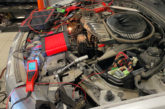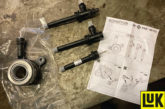
Complete Steering offers its advice to the PMM audience tasked with installing an EPS steering rack.
When installing a remanufactured EPS steering rack, the first and most important thing to do is to remove any fault codes caused by the failed EPS steering rack, from the vehicle ECU using a diagnostic scan tool.
An important thing to note is that if the steering has failed and the light is illuminated on the instrument panel, then a fault code will be present. If your diagnostic scan tool cannot see a fault code, then the scan tool being used is not suitable for completing the installation and an alternative scan tool will need to be used. If fault codes aren’t removed before installing, the original fault codes can transfer to your remanufactured EPS steering rack and embed into the EEPROM chip, thus making the replacement product think it has the same faults as the previously failed unit.
When the fault codes have been removed, the next thing is to disconnect the vehicle battery. Now you can remove the old steering rack safely. A point to note is that you need to be careful when releasing electric connections, as the plugs can be quite brittle and may damage. Now, install the new unit and connect all the wiring connections. Reconnect the vehicle battery.
It is important that you do not turn on the vehicle at this stage.
Getting to it
Attach the diagnostic scan tool via OBD II and turn the ignition on (but do not start the car). Using the diagnostic scan tool, tell the steering system the characteristics of the vehicle, for example: Mazda 6, 5 doors, 2000cc engine, 16 in. wheels etc. An important note at this stage relating to steering replacement on vehicles where the steering ECU is remote from the EPS steering rack, you should re-enter the VIN number during installation of the vehicle characteristics. This allows the steering rack to communicate properly with the vehicle (make sure that your diagnostic scan tool can perform and is suitable for this part of the installation).
During this section of installation, you will need to perform a steering angle sensor calibration. Please note that all EPS steering racks are calibrated during production, however, each one is individual and a calibration to the new steering product is essential.
Where a vehicle has a remote steering ECU, during the testing and simulation of the steering rack in the workshop environment, a stock steering ECU will be used from the specific vehicle. An important note to make is that the steering ECU denotes ‘zero’ position on the vehicle, not the EPS steering rack. The rack and the ECU are calibrated to ‘zero’. However, the ‘zero’ position of the steering ECU on the vehicle may be slightly different to the stock steering ECU used during testing and simulation, therefore the calibration is essential to avoid creeping or wandering of the EPS steering rack.
Typically, all differences fall within 0.5 Nm tolerance and a calibration is simple to perform, however, if the difference is greater than 0.5 Nm, then it will not calibrate and will need to be calibrated at your EPS steering rack remanufacturer, where a slight modification will need to be performed. It can be calibrated with the specific ECU from the vehicle so that they can be paired together ready to be re-installed on the vehicle.
Once calibration is performed, this completes the EPS steering rack installation process, and the vehicle is ready for use. It is now safe to turn on the car and drive it.









